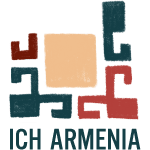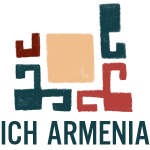Armenian Language
Pre-Written Period. Armenian makes a separate branch in the Indo-European language family, like Greek or Albanian do, without close kinship to other languages. The term “Indo-European” is conventional anyway since we have no knowledge about the real ancestral names of the peoples who are spread over the vast area between India and Europe and who spoke kin languages.
The proto-Indo-European period, when in a certain territory people spoke various dialects of that language (there is no such thing as a period of absolute universality of a language) is traced back to the 5-4 millenniums B.C. Initially, the proto-Indo-European language branched into dialect groups. And, assumingly, there was a time span of close linguistic Armenian-Greco-Indo-Iranian contacts. Those dialects took separate paths to gradually evolve into distinct languages. According to Indo-European experts, the proto-Armenian was conclusively formed approximately five thousand years ago, in the 3rd century B.C.
Views on the exact location where the Indo-European languages originated have been widely diverse. But ever-increasing convincing facts incline scientists to believe that the Near East was the cradle of the Indo-European languages. With this approach, we have to accept that Armenians had not been migrating much around, they are autochthonous to the area.
Some Hittite cuneiform inscriptions of the B.C. 14-13th centuries indicate the existence of a country named Hayasa (hai- aša) which was to be found in the western part of the Armenian highland, but they contain no reference to any people who occupied the area or any information on the language they spoke. Since we know that “asa” is a Hittite place name suffix (aša), we can assume that the land was populated by Armenians and they spoke Armenian. Since we know that “asa” is a Hittite place name suffix (aša), we can assume that the land was populated by Armenians and they spoke Armenian. This hypothesis can be supported by the Armenian roots of some Hayasa place names, like Azzi <, Tsupani <, Artsia <, Aripsa <, etc. In addition, some deity and personal names of the Hayasa language also have Armenian morphology.
In the 4-2nd centuries B.C. Armenian had contacts with ancient non-Indo-European languages of the Near East, such as Sumerian, Akkadian, Hurrian, from which it had direct or indirect borrowings.
The interactions between Armenian and neighbouring other Indo-European languages -Hittite-Luwian, Iranian, Indian, etc. – were in place well after the period of the Indo-European language community, to which fact testify Armenian borrowings from these languages. Armenian also holds very early borrowings from the Caucasian and Kartvelian languages. Historically, Armenian has had the most extended contacts with the Iranian language. That explains why the majority of the borrowings in Armenian that have long become part of its core vocabulary, are of Iranian origin. By the way, the above-mentioned languages also have borrowed words from Armenian.
Scientists often point to the close correlations between the Urartian and Armenian languages. Urartian being a non-Indo-European neighbour language had presumably interacted with Armenian before Urartian incursions into the Armenian highland. With the occupation of Armenia and the creation of the Van Kingdom (Biainili or Urartu) in the 9-6th centuries B.C., the mutual influence of the Armenian and Urartian languages increased. The deciphering of the few survived Urartian cuneiform inscriptions brought to light the mutual borrowings between the two languages, the mutual influence on the phonological and grammatical levels. Unfortunately, since we haven’t identified the patterns of phonetic correlations between the Armenian and Urartian languages, some Armenian place names, like e.g. Van, Yerevan, Gegharkuniq, etc. are sometimes incorrectly attributed to the Urartian forms: Biainili, Erebouni, Ueliku-Ni. Whereas the above mentioned Armenian place names are older, which means they had been in use well before the Urartian invasions.
Written Period. Armenians evidently had been using some written communication means since primaeval times. Up to now, on a regular basis, various pictographic scripts and symbols are being discovered in the Armenian Highland, but their deciphering has not yielded significant results yet. There is no historic evidence of the existence of an Armenian script. But the Armenians are known to have had theatre as far back as in the first century B.C., where in addition to Greek tragedies, plays of their own authors were being staged. Pagan worship sites, which were once centres of the Armenian civilization, served also as premises for studies in theology, astrology, astronomic year numbering, farming, etc. And the works of our historians hold many references to the fact, that after having adopted Christianity as a state religion in 301, the new faith was being spread by destroying pagan temples and burning worship registries, what would have been our ancient literature. But the New Testament was being propagated through original books written in Greek and Assyrian.
The lack of the Holy Book written in the native tongue was a serious impediment to the installation of the new faith, Christianity, in Armenia. Furthermore, in 387 Armenia was split between Byzantium and Persia, which meant the loss of the national unity in addition to the loss of independence. The existence of the Armenian people as a whole entity was under threat. Under those circumstances, it was a matter of urgency to have their own script and literature, which would help unify the divided nation.
At that moment Mesrop Mashtots, a well-educated clergyman who had mastered a number of languages, offered Catholicos Sahak his services in creating the Armenian script. With the support of the Catholicos and Armenian King Vramshapouh, Mesrop Mshtots goes abroad, to explore the alphabets of other peoples. After many years of study of the phonetic and graphic systems of various languages, he acquires the much needed profound knowledge in that sphere. Finally, in 406 he returns to Vagharshapat with the Armenian alphabet and the first Armenian translation of the symbolic line from the Bible’s Book of Fables: “For attaining wisdom and discipline; for understanding words of insight”. In the entire territory of the Armenian lands, both eastern and western, new schools mushroomed offering education in the native tongue, in Armenian letters. Mesrop Mashtots himself organizes and marshals the proceedings. Thus, the Mashtots letters have been serving the Armenian people for over 1600 years.
The new alphabet set afoot the Armenian bibliography with its amazingly orderly structures and rich vocabulary. This fact alone suggests a possibility, that the Grabar (classic Armenian) had been developed and in use in written form before the 4-5th centuries. That literary language had its roots in the central dialects of Armenian (of the Ayrarat and Tourouberan provinces). The 5th century Grabar is called Classic, or of Golden Age, for its structured grammar and rich vocabulary).
Apparently, the Grabar at the time of Mashtots was not the only spoken language in the territory of historic Armenia, since Armenian already had various dialects spoken in different provinces. Most probably the Grabar went through a long period of evolution, both oral or written. The linguistic analysis of some pre-Grabar folklore samples preserved in our old bibliography attest to the fact. The Grabar with its colloquial variety had been in use by the royal court, the clergy and feudal nobility already by the end of the 4th and beginnings of the 5th centuries.
It would be expected from the newly born literary language to evolve constantly, to homogenize grammatical redundancies, but starting from the 6th century, we see increasing instances of penetrations from the colloquial parlance that infringe the Grabar rules. Which can only mean, that it was early for the Grabar to shy away from the status of the spoken communication medium, even for certain social groups. Nevertheless, many an author in ensuing centuries sought to perpetuate the basic grammatical structures and the vocabulary of the Grabar, or the old Armenian.
Nonetheless, the Grabar, which literally means “written, of the written form” had served all Armenians as the main literary language until the mid-19th century. It was instrumental in schooling, in preaching in the church (still is), informal paperwork, in scientific research, literature, etc. Starting from the 5th century on, the Grabar was used to write Movses Khorenatsi’s “Armenian History”, Anania Shirakatsi’s “Geographic Map”, Grigor Narekatsi’s “Book of Prayers” and other great works, including Mikael Chamchian’s voluminous “Armenian History”, of the18th century.
In the course of time, the Grabar, which ceased to be used as an oral communication means, could no more serve as a universal literary language. In parallel with the efforts (notably on the part of the clergy) to safeguard its purity by all possible means, there looms up a spontaneous movement to make the literary language intelligible to common people. Starting from the 10th century, the language of the Armenian bibliography, both scientific and fictional, gradually includes various dialectal penetrations. The merging of the literary and spoken Armenians was more prominent in the Cilician Armenia.
In the 11th century, Armenia was subjected to devastating Seljuk invasions and lost its statehood, which led to extensive emigration of the population. A significant portion of it settled down in neighbouring Cilicia which already had some Armenian communities. The local Armenian feudal lords, having now a stronger backup, in the year of 1080 succeeded in gaining back the western regions of Cilicia from Byzantium and founding an Armenian kingdom that would last for approximately 300 years. Here, steady economic growth also boosts the development of the Armenian culture. To be closer to common people, the written language increasingly and with more ease uses local dialectal elements. Gradually, this new literary variation gets systematized to some degree and becomes the formal literary language of not only the scientific and fictional literature but also of the official paperwork of the Cilician Armenia. It holds good until the country’s dissolution in the 14th century. All through those centuries, in the Armenian provinces of the historic homeland, that had lost its independence, various kinds of works kept on being written, although nowhere to match the Cilician scale. They would be written in a language quite strayed from the Grabar, due to any borrowing. from local dialects.
Hence, the language used in the 12-16th centuries works and official documents is commonly called Middle Age Armenian. It is called so because it bridges the old – Grabar- and the contemporary literary Armenians.
Needless to say, partitioned Armenia, with an economy devastated by succeeding incursions of various tribes and peoples, was in no position to further advance its literary development in that period. Naturally, Middle Armenian couldn’t evolve and mature through another stage of development. Nevertheless, many masterworks of our literature (Nerses Shnorhali, Kouchak, Fric, Naghash Hovnatan), medical books (Mkhtar Gosh, Amirdovlat Amasiatsi) and others, still with practical use, were written in Middle Armenian.
Middle Armenian, too, deviated from the colloquial varieties of the language. Since the 18th century, a group of intellectuals had been raising the issue of adoption of a new literary language that could be intelligible for all Armenians and could unite the nation. The issue matures and requires a solution in the midst of the 19th century. But Armenia was by then divided between the Ottoman and Russian empires, which fact made the task of fashioning one universal literary language impossible. In particular, the clerical elite held that the Grabar, being the idiom of formal education and a systematized one, versus the “ramkakan”, or “ashkharahabar” (the common vernacular), should again obtain the status of the all-Armenian literary language. But progressive intellectuals of both eastern and western parts of Armenia prioritized the development of a literary language intelligible for the common people. The clash of views on this issue in Armenology is coined as “grapaykar”. In eastern Armenia, it was championed by Khachatour Abovian, Stepanos Nazarian, Mikael Nalbandian and others, and in western Armenia, by Gabriel Ayvazian, Arsen Aytenian and many other writers. The concept of upgrading the Ashkharhabar (the common colloquial idiom) to the status of a literary language won in the end, which was supported by the example of Russia and other European countries that had gone through the same process.
Institute of the Language
Armenian National Academy of Sciences


